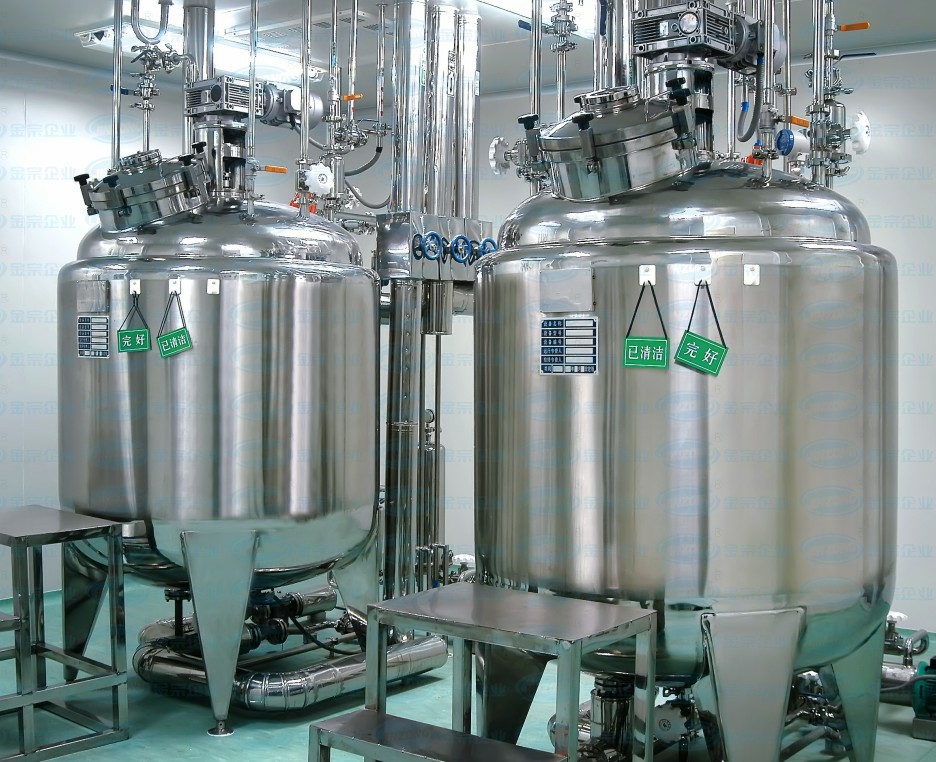As a common chemical equipment, solid material dissolving tank is widely used in pharmaceutical, food, chemical and other fields, mainly used for the dissolution treatment of solid raw materials to ensure that raw materials are uniformly and quickly converted into solution state to meet the needs of subsequent production processes. Jinzong Enterprise will analyze the structure, functional characteristics and working principle of the solid material dissolving tank in detail.

一、Structure of Solid Dissolution Tank
The solid material dissolving tank is mainly composed of tank body, stirring device, heating/cooling system, feed port, discharge port, instrument control unit and so on.
Tank Body:Usually made of stainless steel material, it has good corrosion resistance and cleanliness, ensuring the safety and hygiene standards of contact between solvents and solid materials. The tank design has a suitable volume and can be customized according to production needs.
Stirring Device:One of the core components, including the mixing shaft, mixing blades (such as turbine, frame, blade, etc.), and driving motor. The design of the stirring device needs to consider the characteristics of the material and the dissolution rate, and promote full contact between solid particles and solvents through efficient stirring, accelerating the dissolution process.
Heating/Cooling System:In order to accelerate dissolution or control reaction temperature, the external part of the tank is usually equipped with a heating sleeve or jacket, and the internal part can be heated by steam, hot water, or cooled by cold water. The temperature control system precisely regulates and ensures that the dissolution process takes place at the optimal temperature.
Feed Inlet and Discharge Port:Equipped with sealed and reliable feeding and discharging ports, it facilitates the addition of materials and the output of dissolved solution, while reducing external pollution.
Instrument Control Unit:Including temperature sensors, liquid level gauges, speed controllers, etc., to achieve real-time monitoring and automatic control of parameters such as temperature, stirring speed, and liquid level inside the tank, improving operational safety and efficiency.
二、Function Features
Efficient Dissolution: Through optimized stirring design and temperature control, the dissolution rate and solubility of solid substances are significantly improved, shortening the production cycle.
Uniform Mixing: Ensure that the dissolved solution has a uniform composition, avoid local concentrations that are too high or too low, and improve product quality.
Temperature Control: The application of heating/cooling systems enables the dissolution process to be stable within a specific temperature range, suitable for dissolving temperature sensitive materials.
Easy to Operate: The automation control system simplifies the operation process, reduces manual intervention, and improves production efficiency and safety.
Easy to Clean and Maintain: Designed to comply with GMP standards, the tank body is smooth without dead corners, making it easy to clean and disinfect, and preventing cross contamination.
三、Working Principle
The working process of the solid material dissolution tank is roughly as follows:
Preparation Phase:According to the process requirements, the appropriate amount of solvent is added to the tank, and the heating system is preheated to the predetermined temperature.
Feeding: Slowly add solid materials into the tank through the feeding port on the upper or side, and start the mixing device at the same time。
Dissolution and Stirring: The stirring blade rotates under the drive of an electric motor, generating strong shear forces and eddy currents, promoting full contact, collision, and dispersion between solid particles and solvents, and accelerating the dissolution process. During this process, the dissolution effect can be optimized by adjusting the stirring speed and direction.
Temperature Control: During the entire dissolution process, the temperature inside the tank is continuously monitored and adjusted through a heating or cooling system to maintain the most suitable dissolution conditions.。
Completion and Discharge: When the solid is completely dissolved and the solution reaches the required concentration and uniformity, stop heating and stirring, and discharge the solution through the discharge port for the next step of processing or storage.
In summary, solid material dissolution tanks play an important role in multiple industries due to their high efficiency, controllability, and easy operation. Jinzong Enterprise ensures the efficient and stable dissolution process through carefully designed structures and intelligent control technology, providing strong support for the production of high-quality products.
|
联系我们
全国服务热线 肇庆一分厂:广东省肇庆高新区(大旺)康泰街3号 肇庆二分厂:广东省肇庆高新区(大旺)建设路36号 E-mail: jinzong@jinzong.com.cn
|


